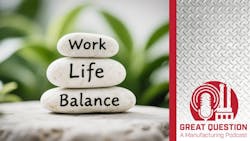Podcast: How Faith Technologies Inc. is embedding mental health into manufacturing safety culture
Key takeaways
- Normalize mental health conversations by embedding them into daily safety talks and team communications to reduce stigma on the shop floor.
- Measure impact with data, using wellness surveys, program participation rates, and health claims to guide continuous improvement.
- Enhance EAP access with faster, flexible options like digital tools and blended care models that meet diverse employee needs.
In this episode of Great Question: A Manufacturing Podcast, Rocky Rowlett, vice president of safety, and Alyssa Kwasny, wellness program director, explain how their energy and construction firm, Faith Technologies Inc., has become an exemplar of world-class safety excellence by developing a culture of care.
Below is an excerpt from the podcast:
EHS: The first question is: in developing your mental health strategies a few years ago, what specific goals and procedures did you use?
RR: Yeah, I think it’s something we worked on as a company. We were growing pretty fast, and we really wanted to make sure we retained a lot of our employees. So, we looked at the softer side of things—what can we do to make these employees feel like they're part of the organization, and not just a number?
A lot of that is the work-life balance piece and really taking care of the employee—mind, body, and soul—not just saying, “Hey, here's some safety training, go to work,” but offering things that can help them while they’re working with us and also outside of work, at home. It's really about taking care of the employee in general.
AK: From my side of things, we do an annual wellness survey, and back in 2020, our team members showed us that about 60% of them were looking for more support on the mental health side.
We’ve always been striving to ensure that we have a true culture of care, so we really try to roll out additional benefits and support initiatives to level up that culture. We’re just trying to create a space where mental well-being is not only supported but normalized.
Especially in a high-stress, high-performance environment like we have in construction and manufacturing, it's really important to reduce the stigma and create a culture of care—where you can be open about your mental health, ask for help when you need it, and not feel embarrassed. It’s OK to not be OK.
EHS: Next question: how did you measure the results of your program? So whether you want to talk about the Culture of Care program or other programs you're currently pursuing.
AK: I really think it's a multi-layered measurement framework that we utilize. Like I said earlier, we conduct that annual wellness survey that helps capture employee sentiment across all levels of well-being. So, for example:
- In 2024, 94% of our team members agreed that the mental health resources and services we offered at FTI met their and their families’ needs.
- 92% said they were familiar with how to access that confidential mental health support through our EAP.
- 85% felt they had the tools and support at work to get the help they needed, when they needed it.
So just those metrics, for example, help us assess awareness, accessibility, and the perceived effectiveness of our mental health offerings.
Coinciding with that, we also look at our health claims and our risk data. So we’re able to identify trends in mental health diagnoses, treatment utilization, and what those cost impacts look like. And that really helps us understand those broader health outcomes and how they're associated with the different initiatives we implement.
EHS: Rocky, this question’s for you: what type of communication strategy did you employ?
RR: It was definitely something new to the field, and we had to get it to our frontline leaders first. You know, they really drive what happens out on the project.
So Alyssa, her team, along with our safety team, rolled out multiple waves of communication—both formalized training and just general information that goes to all of our employees. Every one of our employees has an FTI email. And then every Monday—actually, every day—they get a Safe-to-Book message that goes out, but on Mondays we send out a "Mental Health Monday" communication. That might be a story from one of our employees, or just ways to utilize the resources we have.
So we really rolled it out in several ways. We talk about it in every single onboarding orientation with new employees. And every morning, when our crews assemble to get ready to start their day and talk about their tasks, we have a Culture of Care check-in moment with those groups as well.
So it’s getting hit from multiple angles. It’s just something we knew we had to keep pushing. We’ve had this in place for years now, and it’s really, really worked well for us. We’ve got a lot of good momentum with it, and our frontline leaders do a great job pushing it for us.
About the Podcast
Great Question: A Manufacturing Podcast offers news and information for the people who make, store and move things and those who manage and maintain the facilities where that work gets done. Manufacturers from chemical producers to automakers to machine shops can listen for critical insights into the technologies, economic conditions and best practices that can influence how to best run facilities to reach operational excellence.
Listen to another episode and subscribe on your favorite podcast app
About the Author
Adrienne Selko
Adrienne Selko is senior editor at EHS Today and Material Handling & Logistics. Previously, she was in corporate communications at a medical manufacturing company as well as a large regional bank. Adrienne received a bachelor’s of business administration from the University of Michigan.
